20182320 2019-2020-1 《数据结构与面向对象程序设计》实验6报告
课程:《程序设计与数据结构》
班级: 1823
姓名: 郑力元
学号:20182320
实验教师:王志强
实验日期:2019年10月28日
必修/选修: 必修
1.实验内容
1.1 链表练习,要求实现下列功能:
通过键盘输入一些整数,建立一个链表;
这些数是你学号中依次取出的两位数。 再加上今天的时间。
例如你的学号是 20172301
今天时间是 2018/10/1, 16:23:49秒
数字就是
20, 17,23,1, 20, 18,10,1,16,23,49
打印所有链表元素, 并输出元素的总数。
在你的程序中,请用一个特殊变量名来纪录元素的总数,变量名就是你的名字。 例如你叫 张三, 那么这个变量名就是
int nZhangSan = 0; //初始化为 0.
做完这一步,把你的程序签入源代码控制(git push)。
1.2 链表练习,要求实现下列功能:
实现节点插入、删除、输出操作;
继续你上一个程序, 扩展它的功能,每做完一个新功能,或者写了超过10行新代码,就签入代码,提交到源代码服务器;
从磁盘读取一个文件, 这个文件有两个数字。
从文件中读入数字1, 插入到链表第 5 位,并打印所有数字,和元素的总数。 保留这个链表,继续下面的操作。
从文件中读入数字2, 插入到链表第 0 位,并打印所有数字,和元素的总数。 保留这个链表,并继续下面的操作。
从链表中删除刚才的数字1. 并打印所有数字和元素的总数。
1.3 链表练习,要求实现下列功能:
使用冒泡排序法或者选择排序法根据数值大小对链表进行排序;
如果你学号是单数, 选择冒泡排序, 否则选择选择排序。
在排序的每一个轮次中, 打印元素的总数,和目前链表的所有元素。
在(2)得到的程序中继续扩展, 用同一个程序文件,写不同的函数来实现这个功能。 仍然用 nZhangSan (你的名字)来表示元素的总数。
1.4 在android上实现实验(1)和(2)
1.5 在android平台上实现实验(3)
2. 实验过程及结果
2.1
第一步:编写一个类,代表每一个节点
public class Chain_exp6 {
private int element;
private Chain_exp6 next;
public Chain_exp6(int element) {
this.element = element;
this.next = null;
}
public int getElement() {
return element;
}
public void setElement(int element) {
this.element = element;
}
public Chain_exp6 getNext() {
return next;
}
public void setNext(Chain_exp6 next) {
this.next = next;
}
@Override
public String toString() {
return ""+this.getElement();
}
}
第二步:编写运行代码(解析在注释中)
import java.io.*;
import java.util.Scanner;
public class Chain_6 {
public static Chain_exp6 head;
public static int nZhengLiyuan=0;
public static Chain_exp6 res1;
public static Chain_exp6 res2;
public static void main(String[] args) throws IOException {
Scanner scan=new Scanner(System.in);
//输入
System.out.println("Please input numbers("+(nZhengLiyuan+1)+"):");
String ele=scan.nextLine();
int ele1=Integer.parseInt(ele);
Chain_exp6 chain0=new Chain_exp6(ele1);
head=chain0;
//一直输入、一直创建新的链表并实现连接,直到输入“stop”
while (!ele.equals("stop")){
nZhengLiyuan++;
System.out.println("Please input numbers("+(nZhengLiyuan+1)+"):");
ele=scan.nextLine();
if (ele.equals("stop")){
break;
}
Chain_exp6 chain=new Chain_exp6(Integer.parseInt(ele));
connect(head,chain);
}
//输出
System.out.println("Output?Y/N");
if (scan.nextLine().equals("Y")){
Output(head);
System.out.println("Total amount:"+nZhengLiyuan);
}
}
//用来实现链表之间的连接的静态方法
public static void connect(Chain_exp6 head,Chain_exp6 chn2){
Chain_exp6 headx=head;
while (headx.getNext()!=null){
headx=headx.getNext();
}
headx.setNext(chn2);
}
//用来输出的静态方法
public static void Output(Chain_exp6 head){
Chain_exp6 temp=head;
String temp1="";
while (temp!=null){
temp1=temp1+" "+temp.getElement();
temp=temp.getNext();
}
System.out.println(temp1);
}
//计算链表总结点数量的静态方法
public static int Size(Chain_exp6 head){
int count=0;
while (head!=null){
head=head.getNext();
count++;
}
return count;
}
}
第三步:运行
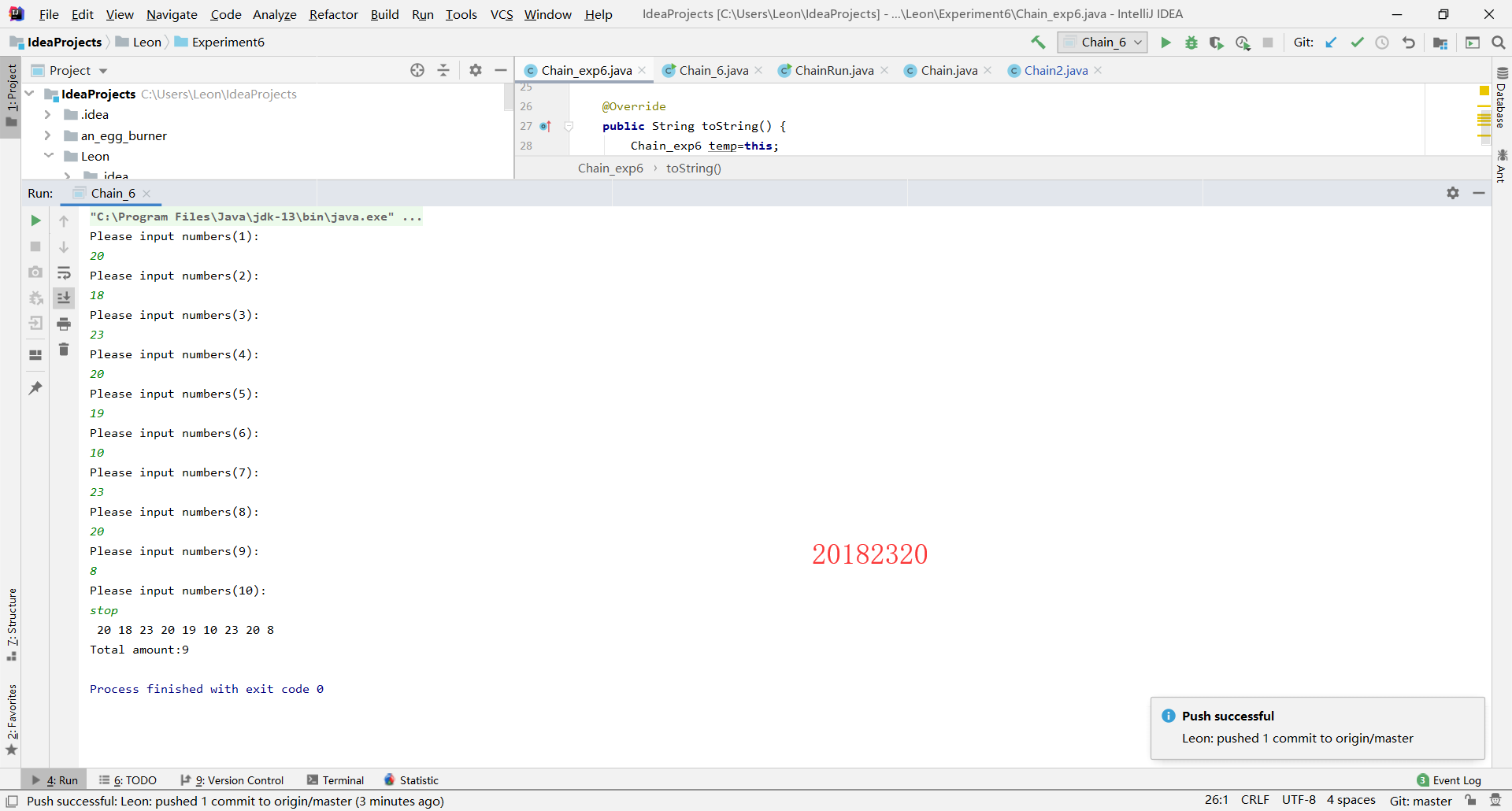
2.2
第一步:节点类代码不用修改,修改、编写运行代码,主要添加以下功能代码:
方法一 实现删除功能的静态方法
public static void delete(Chain_exp6 head,int deletepoint){
Chain_exp6 temp=head;
//如果删除头部,直接修改头指针,之前的头部节点自动丢失
if (deletepoint==1){
Chain_6.head=head.getNext();
}
//若删除中间的节点,如下
else {
//一个个摸到需要删除的节点的前一个
deletepoint--;
for (int i=1;i<deletepoint;i++){
temp=temp.getNext();
}
//把目标节点的前一个节点的指针设置如下,要删除的节点自动丢失
temp.setNext(temp.getNext().getNext());
}
nZhengLiyuan--;
}
方法二 实现插入功能的静态方法
public static void input(Chain_exp6 head, int element, int inpoint){
Chain_exp6 chain2=new Chain_exp6(element);
Chain_exp6 temp=head;
//若插入头部,直接修改头指针到新的节点并进行连接
if (inpoint==1){
chain2.setNext(head);
Chain_6.head=chain2;
}
//插入中间,如下
else {
//一个个摸到要插入的节点前一个
inpoint--;
for (int i=1;i< inpoint;i++){
temp=temp.getNext();
}
//设置新节点的下一个指针为后面的节点
chain2.setNext(temp.getNext());
//设置前一个节点的下一个指针为新节点
temp.setNext(chain2);
}
nZhengLiyuan++;
}
方法三 实现输出功能的方法在上一个实验中已经实现
第二步:在主函数中加入调用上面的功能代码实现功能
//删除
System.out.println("Delete?Y/N");
if (scan.nextLine().equals("Y")){
//提示输入删除点
System.out.println("Please input deletepoint:");
int deletepoint=scan.nextInt();
delete(head,deletepoint);
Output(head);
}
//插入
System.out.println("Input?Y/N");
String temp=scan.next();
if (temp.equals("Y")){
//提示输入插入元素和插入点
System.out.println("Please input inputelement and inputpoint");
int inputelement=scan.nextInt();
int inputpoint=scan.nextInt();
input(head,inputelement,inputpoint);
}
Output(head);
第三步:我选择在主函数中进行文件的写入和读取操作,所以在主函数中加入以下代码
//创建一个文件并输入两个数字(字节流输入)
File f= new File("exp6Writer.txt");
if (!f.exists()){
f.createNewFile();
}
byte bt[]={13,20};
OutputStream os=new FileOutputStream(f);
for (int i=0;i<bt.length;i++){
os.write(bt[i]);
}
os.close();
//从文件中读取数字并插入链表(字节流读取)
Integer[] num=new Integer[2];
InputStream is=new FileInputStream(f);
System.out.println("The number read from the file:");
for (int i=0;i<=is.available();i++){
num[i]=(Integer)is.read();
System.out.println(num[i]+" ");
}
//插入到链表第五位
input(head,num[0],5);
Output(head);
//保留链表,一个节点一个节点进行对应赋值
Chain_exp6 head1=head;
res1=new Chain_exp6(head1.getElement());
while (head1.getNext()!=null){
res1.setElement(head1.getElement());
head1=head1.getNext();
Chain_exp6 n=new Chain_exp6(head1.getElement());
res1.setNext(n);
res1=res1.getNext();
}
//插入到链表第一位
input(head,num[1],1);
Output(head);
//保留链表,一个节点一个节点进行对应赋值
res2=new Chain_exp6(head1.getElement());
while (head1.getNext()!=null){
res2.setElement(head1.getElement());
head1=head1.getNext();
Chain_exp6 n=new Chain_exp6(head1.getElement());
res2.setNext(n);
res2=res2.getNext();
}
//删除数字1
//因为在第五位插入数字1后又在第一位插入了一个数字2
//所以这里数字1正处于第6的位置
delete(head,6);
Output(head);
//打印元素总数
System.out.println("Total amount:"+Size(head));
第四步:运行
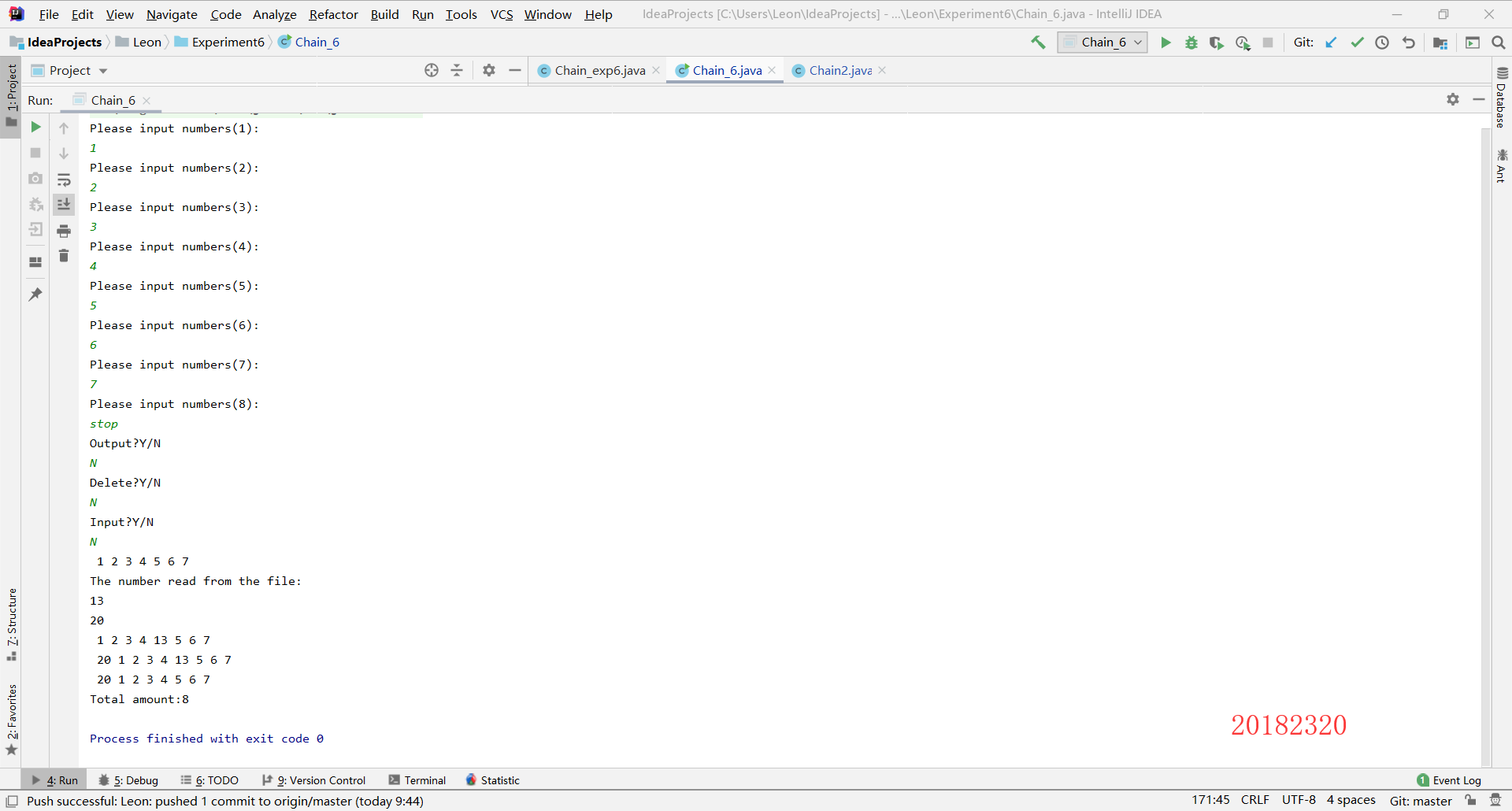
2.3
第一步:编写实现排序功能的静态方法(冒泡排序)
public static void Rank(){
Chain_exp6 temp=Chain_6.head;
Chain_exp6 c1,c2;
int i=0,j=0;
if (temp==null||temp.getNext()==null){
Output(Chain_6.head);
}
else {
int x,y;
for (i=1;i<nZhengLiyuan;i++){
for (j=i+1;j<=nZhengLiyuan;j++){
c1=c2=Chain_6.head;
//通过数字,一个个摸到需要交换的两个节点
for (x=1;x<i;x++){
c1=c1.getNext();
}
for (y=1;y<j;y++){
c2=c2.getNext();
}
//只进行元素的交换
if (c1.getElement()<c2.getElement()){
int t;
t=c1.getElement();
c1.setElement(c2.getElement());
c2.setElement(t);
System.out.println("Context:");
Output(head);
//每次交换都输出一次链表和元素总数
System.out.println("Total amount:");
System.out.println(nZhengLiyuan);
}
}
}
}
}
第二步:在主方法中调用排序方法
Rank();
第三步:运行
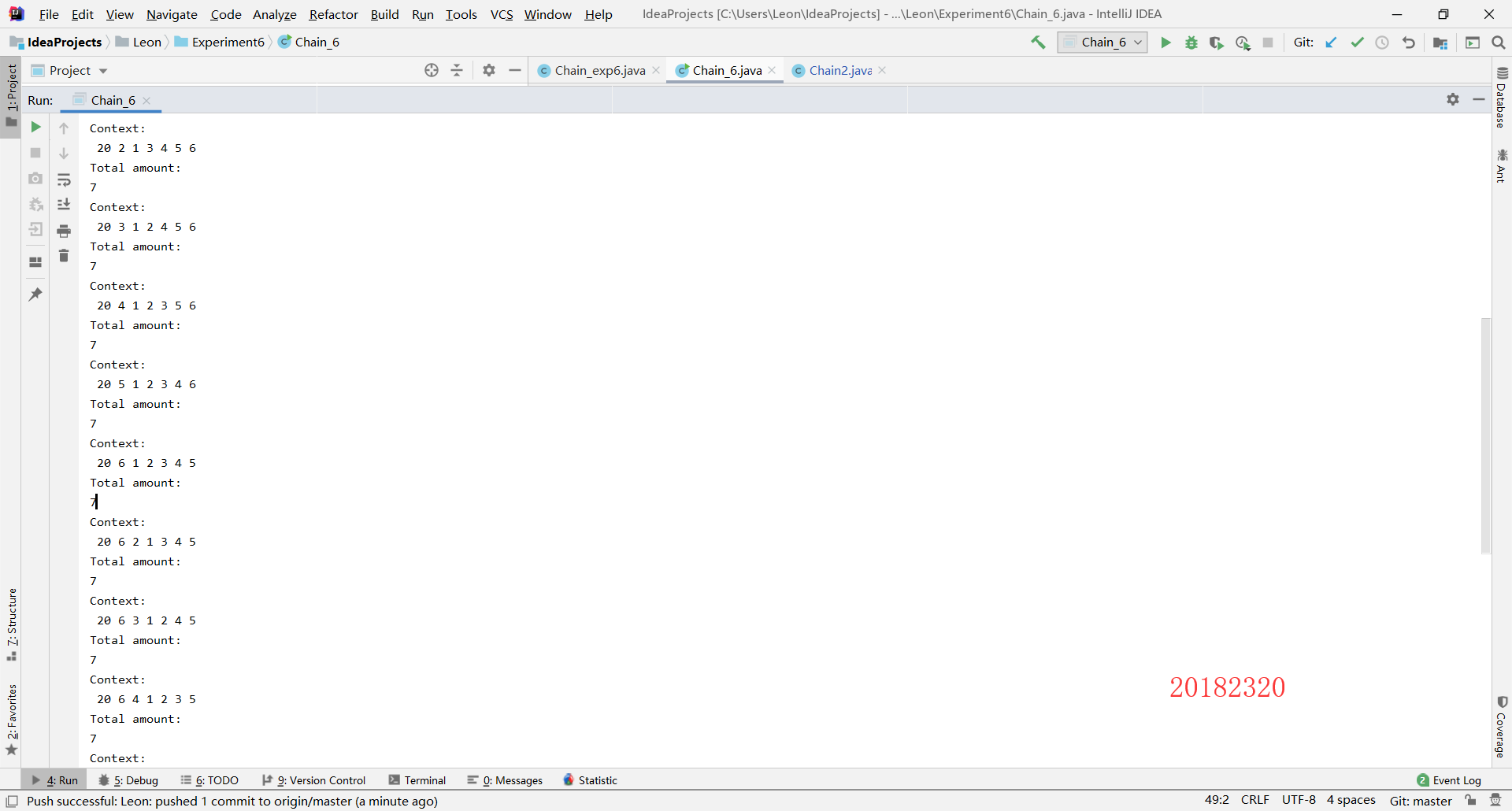
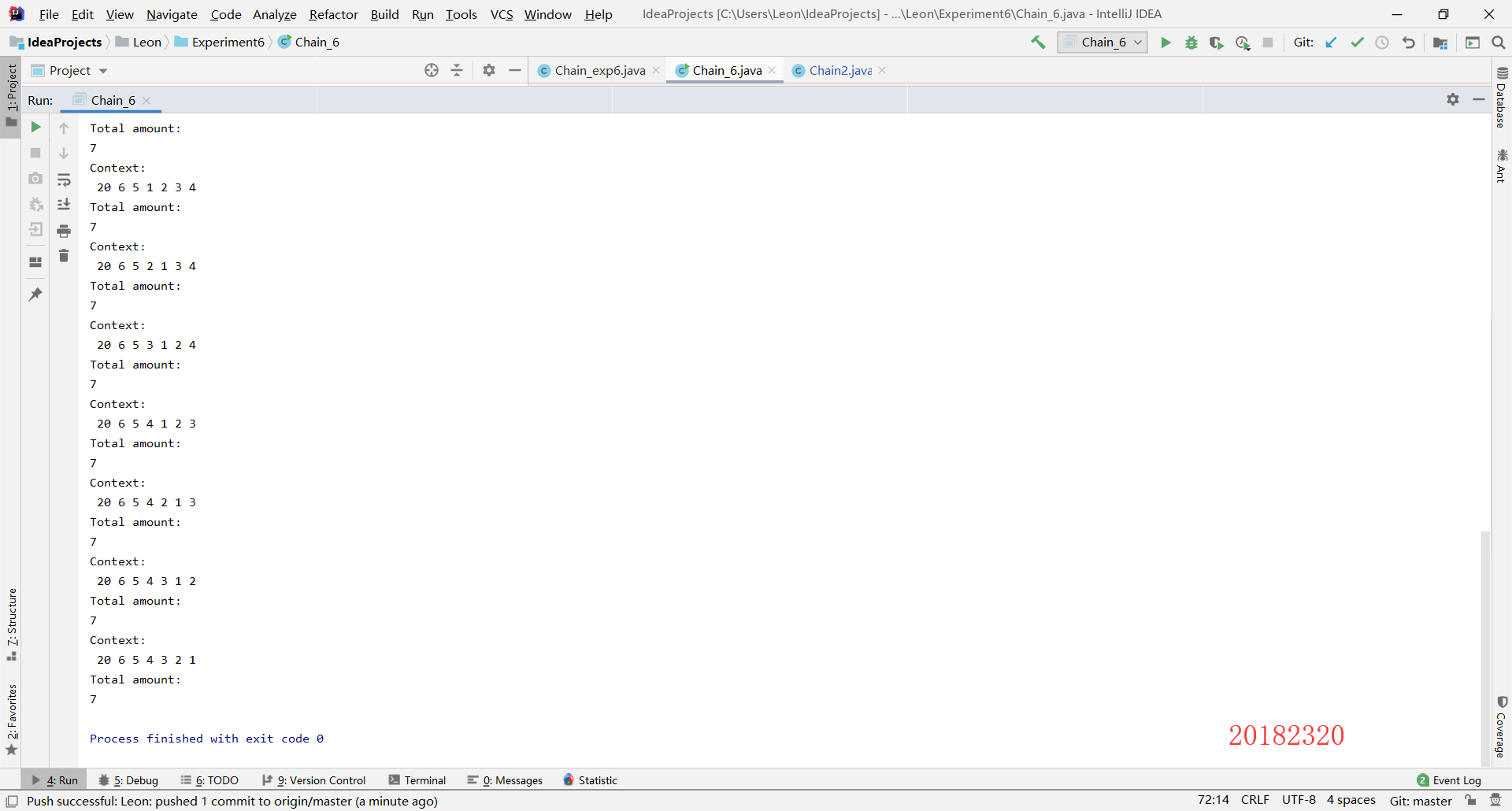
2.4
在安卓中实现idea,无非就是输入和输出的实现方式不同,需要转换,别的内容基本可以直接照着上面复制。
第一步:设置布局
因为这个实验涉及用户的输入以及对输入内容的处理,所以我设置了两个活动,由第一个活动实现链表的输入,并启动第二个活动,将链表传给第二个活动进行处理和输出。
布局1:主活动的布局
<GridLayout xmlns:android="http://schemas.android.com/apk/res/android"
android:layout_width="wrap_content"
android:layout_height="wrap_content"
android:layout_gravity="center"
android:columnCount="3"
>
//创建EditText组件来实现文本输入
<TextView android:text="Numbers:"/>
<EditText
android:id="@+id/Numbers"
android:layout_width="200dp"
android:layout_columnSpan="2"/>
//创建一个Button来启动第二个活动
<Button
android:id="@+id/Enter"
android:layout_width="wrap_content"
android:layout_height="wrap_content"
android:layout_column="2"
android:layout_gravity="right"
android:text="Submit"
android:onClick="Start"/>
</GridLayout>
布局2:第二个活动的布局
以下我创建了11个textView来实现文本的输出,并创建了一个布局LinearLayout来方便实现textView的动态创建。
<?xml version="1.0" encoding="utf-8"?>
<LinearLayout xmlns:android="http://schemas.android.com/apk/res/android"
android:orientation="vertical"
android:layout_width="match_parent"
android:layout_height="match_parent">
<LinearLayout
android:id="@+id/Second"
android:layout_width="fill_parent"
android:layout_height="wrap_content"
android:layout_marginBottom="9dp"
android:orientation="vertical">
</LinearLayout>
<TextView
android:id="@+id/textView1"
android:layout_width="match_parent"
android:layout_height="wrap_content"
android:text=""
android:textAppearance="@style/TextAppearance.AppCompat.Medium" />
<TextView
android:id="@+id/textView2"
android:layout_width="match_parent"
android:layout_height="wrap_content"
android:text=""
android:textAppearance="@style/TextAppearance.AppCompat.Medium" />
<TextView
android:id="@+id/textView3"
android:layout_width="match_parent"
android:layout_height="wrap_content"
android:text=""
android:textAppearance="@style/TextAppearance.AppCompat.Medium" />
<TextView
android:id="@+id/textView4"
android:layout_width="match_parent"
android:layout_height="wrap_content"
android:text=""
android:textAppearance="@style/TextAppearance.AppCompat.Medium" />
<TextView
android:id="@+id/textView5"
android:layout_width="match_parent"
android:layout_height="wrap_content"
android:text=""
android:textAppearance="@style/TextAppearance.AppCompat.Medium" />
<TextView
android:id="@+id/textview6"
android:layout_width="match_parent"
android:layout_height="wrap_content"
android:text=""
android:textAppearance="@style/TextAppearance.AppCompat.Medium" />
<TextView
android:id="@+id/textView7"
android:layout_width="match_parent"
android:layout_height="wrap_content"
android:text=""
android:textAppearance="@style/TextAppearance.AppCompat.Medium" />
<TextView
android:id="@+id/textView8"
android:layout_width="match_parent"
android:layout_height="wrap_content"
android:text=""
android:textAppearance="@style/TextAppearance.AppCompat.Medium" />
<TextView
android:id="@+id/textView9"
android:layout_width="match_parent"
android:layout_height="wrap_content"
android:text=""
android:textAppearance="@style/TextAppearance.AppCompat.Medium" />
<TextView
android:id="@+id/textView10"
android:layout_width="match_parent"
android:layout_height="wrap_content"
android:text=""
android:textAppearance="@style/TextAppearance.AppCompat.Medium" />
<TextView
android:id="@+id/textView11"
android:layout_width="match_parent"
android:layout_height="wrap_content"
android:text=""
android:textAppearance="@style/TextAppearance.AppCompat.Medium" />
</LinearLayout>
第二步:清单的编写
注意在清单中做好两个活动的注册,不然程序会闪退。
<?xml version="1.0" encoding="utf-8"?>
<manifest xmlns:android="http://schemas.android.com/apk/res/android"
package="com.example.exp6_4">
<application
android:allowBackup="true"
android:icon="@mipmap/ic_launcher"
android:label="@string/app_name"
android:roundIcon="@mipmap/ic_launcher_round"
android:supportsRtl="true"
android:theme="@style/AppTheme">
<activity android:name=".MainActivity"
android:label="@string/app_name">
<intent-filter>
<action android:name="android.intent.action.MAIN" />
<category android:name="android.intent.category.LAUNCHER" />
</intent-filter>
</activity>
<activity android:name=".Second"
android:label="Activity">
</activity>
</application>
</manifest>
第三步:编写第一个活动和第二个活动的Java程序
主活动代码:
import androidx.appcompat.app.AppCompatActivity;
import android.content.Intent;
import android.os.Bundle;
import android.view.View;
import android.widget.Button;
import android.widget.EditText;
public class MainActivity extends AppCompatActivity {
private EditText input;
private Button enter;
@Override
protected void onCreate(Bundle savedInstanceState) {
super.onCreate(savedInstanceState);
setContentView(R.layout.activity_main);
initView();
}
//创建方法完成组件的指向
public void initView(){
input=(EditText)findViewById(R.id.Numbers);
enter=(Button)findViewById(R.id.Enter);
}
//创建方法来启动第二个活动
public void Start(View view) {
Intent intent=new Intent(MainActivity.this,Second.class);
intent.putExtra("message",input.getText().toString());
startActivity(intent);
}
}
第二个活动的代码:
主体代码参考上面Idea,这里仅给出不太一样的地方:
输出方法
public void SOUT(int id,String content){
((TextView)findViewById(id)).setText(content);
}
文件读入的实现
首先在单元文件夹下面创一个目录assets,并在里面创一个写有两个数字的txt文件

然后再第二个活动的Java文件中加入文件读取方法
public void FileReader() throws IOException {
//创建流,并使用getAssets方法读取文件内容,最后转换为字符串再转换为数字并输出
InputStream inputStream =getAssets().open("test.txt");
int size=inputStream.available();
byte [] bytes=new byte[size];
inputStream.read(bytes);
inputStream.close();
String str=new String(bytes);
StringTokenizer stn=new StringTokenizer(str," ");
Chain6_4 temp1=new Chain6_4(Integer.parseInt(stn.nextToken()));
Second.Connect(head,temp1);
第四步:运行
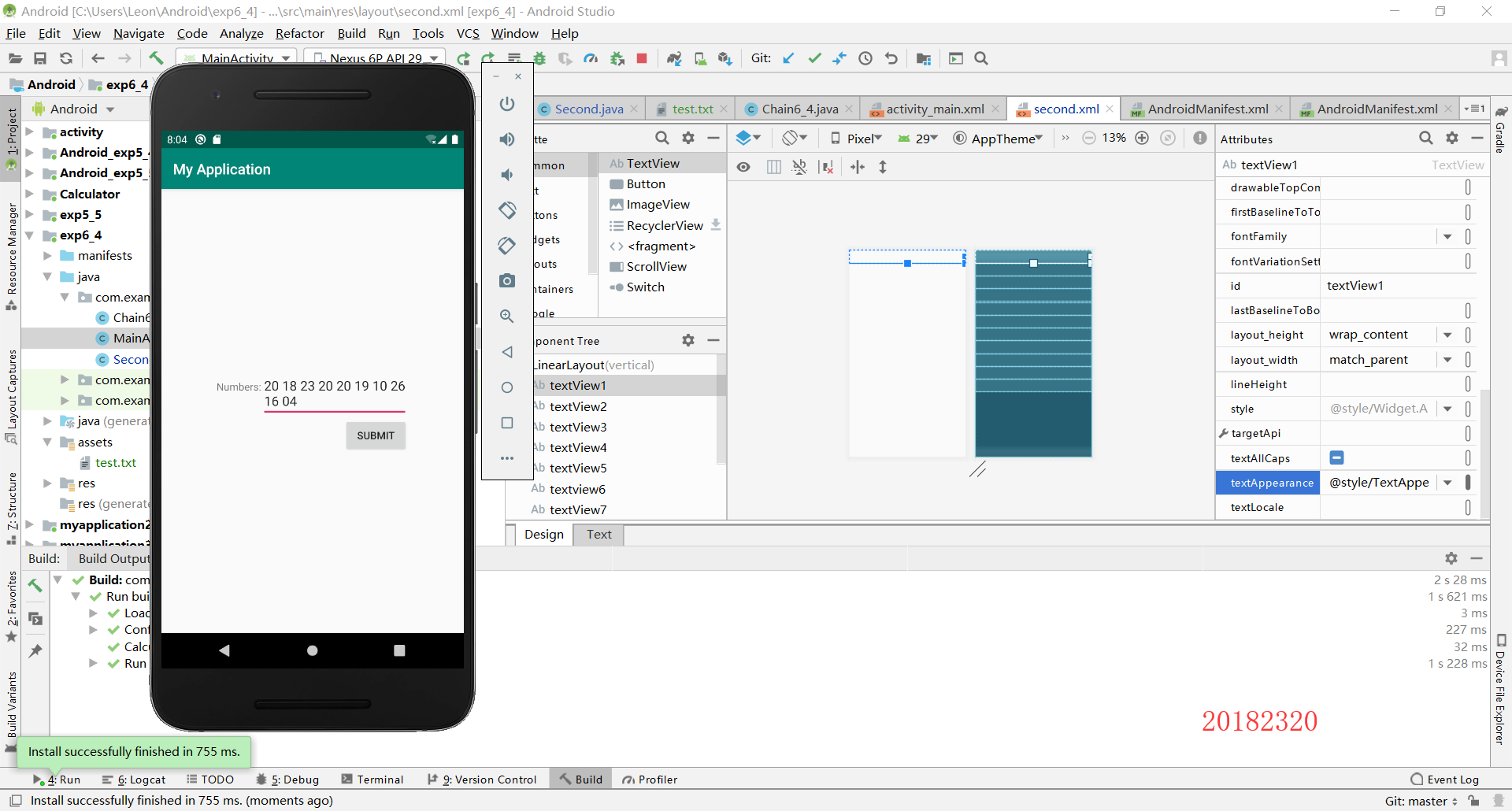

2.5
这个实验只需要把再idea实现的排序方法再实现一次就行了,不过需要注意一下动态创建textView,方法如下:
动态输出的实现
(动态创建textView,使用setText方法修改后,用addView方法加到布局中)
TextView textViewi=new TextView(this);
textViewi.setText("Context:");
layout.addView(textViewi);
先实现排序,再辅以上面这个方法实现输出

3. 实验过程中遇到的问题和解决过程
问题1:
在idea实现文件读写时,出现路径被拒绝访问的情况

问题1解决:
因为创建在C盘的用户路径下,程序不具有访问权限,因此直接使用文件创建的方法,可以默认创建在当前project的文件路径下。
问题2:
本来想再第二个活动中像第一个布局一样用EditText实现用户的输入,但是发现程序会闪退。
问题2解决:
发现是涉及监听回调的问题
问题3:
在安卓中面临文件读取问题时,曾想着用idea中的文件读写方法创建文件、写入文件最后在读取,结果发现在Everything中都查不到本应该创建好了的txt文件。
问题3解决:
如上2.4
其他(感悟、思考等)
在Android Studio中,布局的熟练使用对开发软件非常重要。合理的布局不仅能让程序更好看,还能让你充分运用组件的功能,达到你的开发目的。因此布局需要我们认真学习。
链表的优点有可以无限扩展、灵活度高等,但是不适用于需要频繁读取写入的程序中。